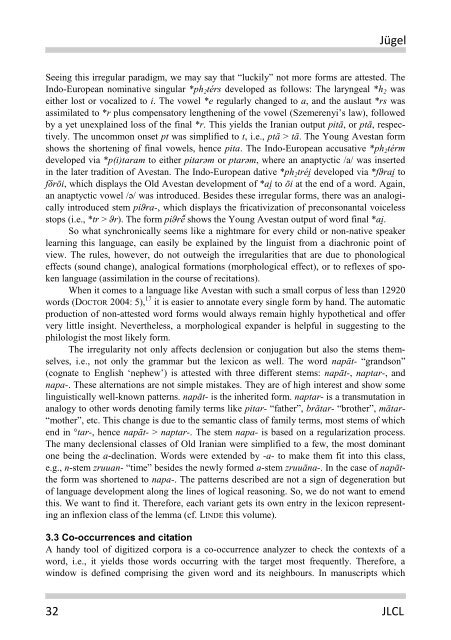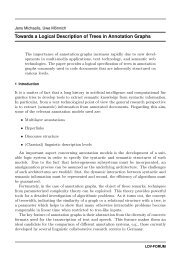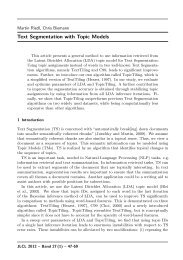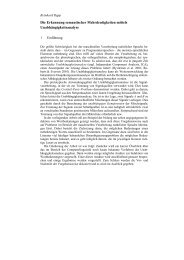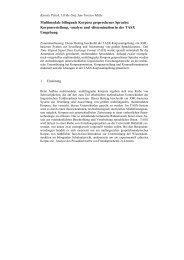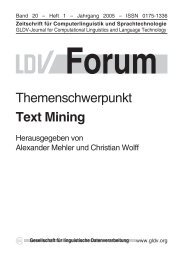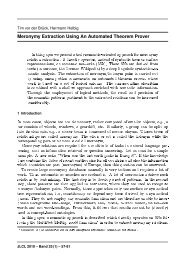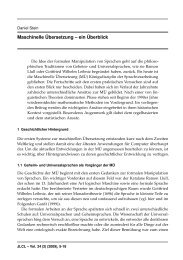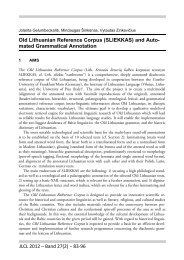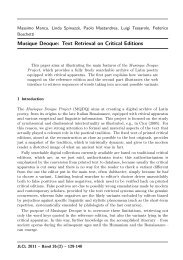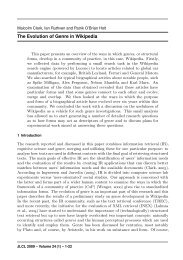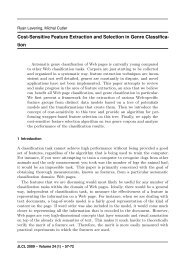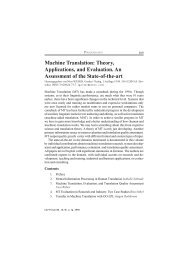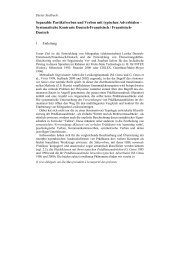Heft 2/2012 - JLCL
Heft 2/2012 - JLCL
Heft 2/2012 - JLCL
Create successful ePaper yourself
Turn your PDF publications into a flip-book with our unique Google optimized e-Paper software.
Jügel<br />
Seeing this irregular paradigm, we may say that “luckily” not more forms are attested. The<br />
Indo-European nominative singular *ph 2 térs developed as follows: The laryngeal *h 2 was<br />
either lost or vocalized to i. The vowel *e regularly changed to a, and the auslaut *rs was<br />
assimilated to *r plus compensatory lengthening of the vowel (Szemerenyi’s law), followed<br />
by a yet unexplained loss of the final *r. This yields the Iranian output pitā, or ptā, respectively.<br />
The uncommon onset pt was simplified to t, i.e., ptā > tā. The Young Avestan form<br />
shows the shortening of final vowels, hence pita. The Indo-European accusative *ph 2 térm<br />
developed via *p(i)taram to either pitarəm or ptarəm, where an anaptyctic /a/ was inserted<br />
in the later tradition of Avestan. The Indo-European dative *ph 2 tréi̯ developed via *fϑrai̯ to<br />
fδrōi, which displays the Old Avestan development of *ai̯ to ōi at the end of a word. Again,<br />
an anaptyctic vowel /ə/ was introduced. Besides these irregular forms, there was an analogically<br />
introduced stem piϑra-, which displays the fricativization of preconsonantal voiceless<br />
stops (i.e., *tr > ϑr). The form piϑrē̆ shows the Young Avestan output of word final *ai̯ .<br />
So what synchronically seems like a nightmare for every child or non-native speaker<br />
learning this language, can easily be explained by the linguist from a diachronic point of<br />
view. The rules, however, do not outweigh the irregularities that are due to phonological<br />
effects (sound change), analogical formations (morphological effect), or to reflexes of spoken<br />
language (assimilation in the course of recitations).<br />
When it comes to a language like Avestan with such a small corpus of less than 12920<br />
words (DOCTOR 2004: 5), 17 it is easier to annotate every single form by hand. The automatic<br />
production of non-attested word forms would always remain highly hypothetical and offer<br />
very little insight. Nevertheless, a morphological expander is helpful in suggesting to the<br />
philologist the most likely form.<br />
The irregularity not only affects declension or conjugation but also the stems themselves,<br />
i.e., not only the grammar but the lexicon as well. The word napāt- “grandson”<br />
(cognate to English ‘nephew’) is attested with three different stems: napāt-, naptar-, and<br />
napa-. These alternations are not simple mistakes. They are of high interest and show some<br />
linguistically well-known patterns. napāt- is the inherited form. naptar- is a transmutation in<br />
analogy to other words denoting family terms like pitar- “father”, brātar- “brother”, mātar-<br />
“mother”, etc. This change is due to the semantic class of family terms, most stems of which<br />
end in °tar-, hence napāt- > naptar-. The stem napa- is based on a regularization process.<br />
The many declensional classes of Old Iranian were simplified to a few, the most dominant<br />
one being the a-declination. Words were extended by -a- to make them fit into this class,<br />
e.g., n-stem zruuan- “time” besides the newly formed a-stem zruuāna-. In the case of napātthe<br />
form was shortened to napa-. The patterns described are not a sign of degeneration but<br />
of language development along the lines of logical reasoning. So, we do not want to emend<br />
this. We want to find it. Therefore, each variant gets its own entry in the lexicon representing<br />
an inflexion class of the lemma (cf. LINDE this volume).<br />
3.3 Co-occurrences and citation<br />
A handy tool of digitized corpora is a co-occurrence analyzer to check the contexts of a<br />
word, i.e., it yields those words occurring with the target most frequently. Therefore, a<br />
window is defined comprising the given word and its neighbours. In manuscripts which<br />
32<br />
<strong>JLCL</strong>


